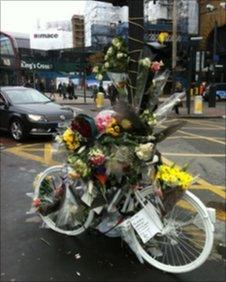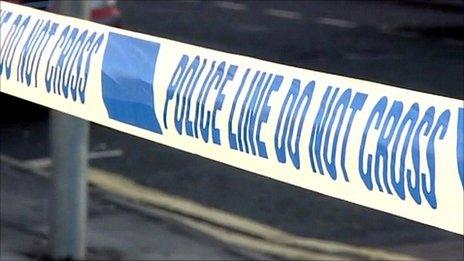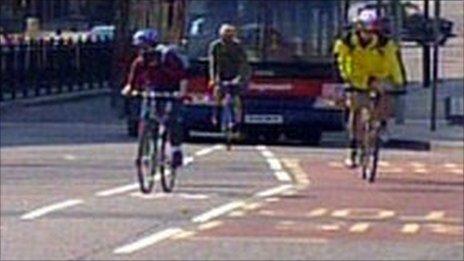Pressure mounts on mayor and TfL to make cycling safer
- Published
- comments
The pressure seems to be growing on the mayor and Transport for London (TfL) to do more to make junctions safer for cyclists.
Outside King's Cross there is now a pile of flowers and a ghost bike tribute to a cyclist who died there. Many deaths seem to involve HGVs and junctions.
On Wednesday, the London Assembly tried to push for more action from the Mayor, but both he and the Transport Commissioner Peter Hendy doubted whether changing road designs could have saved any of the 14 cyclists that have died in the capital this year.
However there are many others who say that if the junctions were better designed, then cyclists' lives could be saved.
Worst junctions
TfL wants hauliers to do more and have more training and technology to alert drivers to cyclists.
It also wants cyclists themselves to avoid blindspots on trucks, something that nearly every cyclist I know with any sense already does.
One of the interviewees in my TV piece is organising a demonstration on Saturday, external.
Cyclists will travel to the 10 worst junctions for casualties in the capital.
The challenge for TfL is how to alter junctions without making the experience worse for other road users.

A ghost bike tribute and flowers where a cyclist died near King's Cross
TfL issued a pre-emptive press release before London Assembly members had started questioning it on cycling.
Reduction in deaths
It said: "While every collision is regrettable, it is encouraging that the proportion of cycling collisions on TfL roads that result in fatal or serious injuries has declined since 2008, indicating that the severity of collisions is falling.
"So far, during 2011 there have tragically been 14 cycling fatalities on the capital's roads, seven of which involved HGVs or tipper trucks. A huge range of practical measures are being delivered by the Mayor and TfL to tackle the issue and make the city's streets safer for cyclists."
Since 2010, TfL has been working to deliver its Cycle Safety Action Plan (CSAP).
It identified 52 targeted actions which the mayor, TfL and other stakeholders need to take to reduce the number of cyclists being killed and seriously injured on London's roads.
- Published25 October 2011

- Published19 October 2011
- Published8 June 2011
